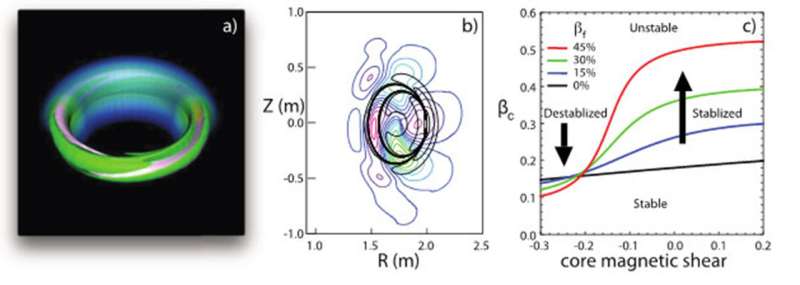Eliminating small instabilities in tokamaks before they become disruptions

One of the greatest obstacles to producing energy via fusion on Earth is the formation and growth of small magnetic field imperfections in the core of experimental fusion reactors. These reactors, called tokamaks, confine hot ionized gas, or plasma. If the imperfections persist, they let the energy stored in the confined plasma leak out; if allowed to grow, they can lead to sudden termination of the plasma discharge. Recent simulations of tokamak discharges with fast, energetic ions have shown that the structure of the magnetic field can either stabilize or destabilize these magnetic imperfections, or "tearing" instabilities. The result depends on the helical structure of the field as it winds around the tokamak.
Energetic ions, ubiquitous in fusion plasmas, can be a strong stabilizing or destabilizing force. The choice depends on the magnetic shear in the plasma. Understanding the physics driving the onset of the instabilities can lead to their avoidance, a "zero tolerance" approach, vital for ITER's stable operation. ITER is a key step between today's fusion research and tomorrow's fusion power plants. Also, the results explain many experimental observations of tearing instabilities that limit the maximum heat energy that can be contained.
Advanced tokamaks achieve high-thermal-energy plasmas by injecting beams of hot ions that collide with, and thereby heat, the background plasma. Burning plasma experiments that create energy from fusion reactions, such as ITER, will also have a significant population of hot alpha particles, the byproduct of fusion. The effects that energetic ions have on the benign instabilities, such as the sawtooth instability, which causes the temperature near the plasma core to flatten, and the toroidal Alfvén eigenmode, which intuitively is a "vibration" (wobble) of the magnetic field lines, have been known for some time.
As the current and confined energy in plasmas are increased, a "stability boundary" can be crossed when the thermal pressure (that is, the heat energy) exceeds a certain fraction of the magnetic energy that comprises the magnetic bottle that confines the plasma. These "tearing" instabilities create imperfections in the magnetic field. If these imperfections grow, they can trigger a large-scale disruption, which terminates the plasma confinement and can damage the machine. Simulations of tokamak discharges with fast, energetic ions have shown the emergence of a stabilizing influence, or force, to the disruptive instabilities. Whether the force is stabilizing or destabilizing depends on the "shear," which measures how the magnetic field lines wrap around the bagel-shaped, or toroidal, plasma in the tokamak. In positive shear, the usual case, the energetic ions are stabilizing.
However, the inner region of tokamaks can often have low or negative (reversed) magnetic shear, and this leads to a destabilizing force, enough to drive the tearing mode unstable, thereby possibly leading to a disruption. As we move toward controlled avoidance of disruptions in ITER, it will be critical to incorporate advanced stability models into active control strategies in order avoid unstable conditions.
More information: M. R. Halfmoon et al. A model of energetic ion effects on pressure driven tearing modes in tokamaks, Physics of Plasmas (2017). DOI: 10.1063/1.4984772
D.P. Brennan, C.C. Kim, and R.J. La Haye, "Energetic particle effects on n=1 resistive MHD instabilities in a DIII-D hybrid discharge." Nuclear Fusion 52, 033004 (2012).
R. Takahashi et al. Kinetic Effects of Energetic Particles on Resistive MHD Stability, Physical Review Letters (2009). DOI: 10.1103/PhysRevLett.102.135001
Journal information: Physical Review Letters , Physics of Plasmas
Provided by US Department of Energy





















